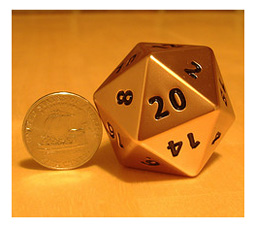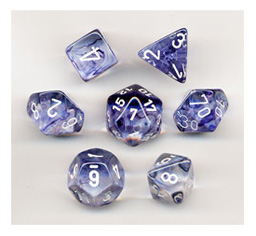Comparing the vast, electrified skyline of a modern city with the stark simplicity suggested by an ancient ruin, it’s easy to see that man has changed his environment a great deal over the past millennia. But has man’s nature changed along with his environment? Not really. Take the institution of dice gambling, for instance. We know that prehistoric man used dice much like ours, played dice games similar to our own, and to seal the argument, cheated his opponents with loaded dice.

The card catalogue of any large library will illustrate the age-old controversy over dice gambling. Almost as soon as man had developed the printing press, he began to publish treatises for or against the innocuous little cubes, mostly against. The flavor of those early works, is suggested by one 16th century treatise published in England and entitled “A Manifest Detection of the Most Vyle and Detestable Use of Dice Play.” A bit heavy handed, perhaps, but you get the idea.
Dice are the oldest gaming implements known to man. Before dice became gaming pieces, numbered cubes were used as magical devices for divining the future. The next time you’re searching for a word to stump a self proclaimed vocabulary know it all, try “astragalomancy”, that’s the practice of divination by means of dice.
Primitive man probably used cubical knucklebones or the ankle bones of sheep for his gaming pieces. The Arabic word for knucklebone, is in fact, the same for dice. Even today, experienced elbow shakers often call dice “bones” or “devil’s bones”.
Archaeologists have shown that dice predate the written word, and can be found in almost every culture in the world, including the American Indian, Eskimo, and African. Excavations in Egypt have turned up stone dice dating from 2,000 BC that look remarkably similar to the modern thing.
For his dice ancient man used, among other things, plum and peach pits, stones, seeds, bones, horn, pottery, pebbles, shells, and beaver teeth.
The Greeks and Romans were heavy gamers, favoring dice of bone or ivory and occasionally of semi-precious stone. Even Plato was not one to take the art lightly, writing that “nobody can become a skilled dice player if he has not devoted himself to it from his childhood, but only plays for pleasure.”
The Bible mentions that Roman soldiers cast lots for Christ’s robe after crucifixion. The Emperor Claudius went so far as to publish a book on dice games. And Julius Caesar, at the Rubicon, uttered the famous words, “Jacta alea est” – “the die is cast”.
To mark the spots or “pips” of his dice, early man either bored holes in the cubes or carved circular marks on the faces. He was also quite adept at loading dice. The earliest records of man mention both dice and crooked dice. Dice especially made for cheating have been found in the tombs of Egypt, of Asia, and of the Americas.
Modern man has improved both the manufacture of dice and the methods of loading them. Today’s galloping ivories are usually made of cellulose or plastic. There are basically 2 varieties, “casino” dice and “drugstore” dice.
Casino dice are handmade, sawed from plastic rods, and perfectly cubical to within one five-thousandth of an inch. Casino dice three-quarters of an inch on a side are most often used for casino games of craps.
The drugstore die is smaller, machine made, and seldom as perfectly cubical as the casino die. “Peewee” dice are only a quarter-inch wide on a side. At various times, dice have been fashioned in the shape of a pyramid, pentagon, and octagon.
In the manufacture of casino dice, each spot is drilled precisely 17 thousandth of an inch into the face, them filled with paint weighing exactly the same as the plastic removed for the hole. Thus, the die remains balanced on all sides.
So much for honest dice. Though the ages, man has devised a number of ways to improve his odds at “indoor golf”. The most familiar way is “loading” the dice, a weight of some kind is placed inside the die against one face, thereby assuring that the opposite face will come up more often than one might mathematically expect.
There are some more subtle methods, however. “Shapes” are dice with one slightly sawed-off edge. The longer faces are more likely to come up than the shortened faces, imagine rolling a brick and trying to leave one of the narrow sides up.

“Tops” or “bottoms” are dice with incorrectly numbered faces. Instead of the numbers one through six, a “tops” die might show the numbers 3, 4, and 5, each repeated on two faces. When used in conjunction with a die reading 1, 5, and 6, the pair cannot produce a seven.
You’re not likely to be fooled by such a crass trick, you say? Keep in mind only 3 faces of the die are visible to you at any one time. A good dice cheat can slip his “tops” by sleight of hand and withdraw them from play before you can say “Rip off”.
A good dice cheat can bilk you even with honest dice. There are ways to “spin” the dice to improve the chances of certain combinations. Your best bet is to immediately suspect anyone who suggests a game of craps and just happens to have his own ivories on hand.
That brings us to the subject of craps. The game is American in origin, a variant of an old European game known as “hazard” that was popular in London in the seventeenth and eighteenth centuries. In fact, the 1-1 and 1-2 combinations in hazard have been known as “crabs” since the sixteenth century.
According to some accounts, the origin of craps can be traced to Bernard de Mandeville, a Frenchman who brought the game of hazard to New Orleans in 1813. Since the nickname for Creoles was Johnny Crapauds, the game became known as the Crapaud’s game, and later, simply craps. Mandeville, himself, lost a fortune at the game, and was forced to sell his New Orleans property to pay his debts. A Street cut though his land was called Craps Street. It later changed to Burgundy Street.
Black Americans around New Orleans are often credited with developing the game of craps as it is played today. They also left us with a wealth of dice slang. There’s hardly any need to tell you what “Mississippi marbles” or “Memphis dominos” are. Or “snake eyes”, or “boxcars”. How about “Little Joe from Kokomo”? Fours, my friend. And let’s not forget that worn out exhortation, “Come on mama, baby needs a new pair of shoes”!
A New York dicemaker by the name of John H. Winn, that’s right, Winn, has been called the first craps banker in history, and is credited with the invention of open craps, that variety of elbow athletics you’re most likely to find in an alley or pool hall. Craps was spread by American soldiers during the 2 World Wars. Today, a variant known as “bank craps” is played in casinos throughout the world.
Most experienced casino gamblers consider bank craps the casino game which offers the player the greatest chance to walk away a winner. Some also nominate craps as the most exciting of all casino games. It’s certainly the most colorful to watch. Early in the 19th century, many American drugstores and soda fountains offered counter dice games to their patrons. Counter games are still legal in some parts of the country. Some of the descriptively names games still enjoyed by the Americans include Drop Dead, Pig, Heaven and Nine, and Hooligan. When you think of it, craps isn’t bad either!
Today, backgammon is rapidly becoming one of the most popular board games in America. The fact is, backgammon is much older than craps, ranking as the oldest dice game still widely played. The ancient Romans played a variety of backgammon. And as far as the name, etymologists trace it either to the Saxon expression “bac gamen”, which means “back game”, or the Welsh back gamon, “little battle”.

There are literally thousands of other games that employ the timeless cubes, Despite the use of cards and spinners, dice remain, quite simply, the best way of introducing the element of chance into any game, no matter how complex. As Mallarme suggested in the title of one of his most famous poems, “A Throw of the Dice Never Will Abolish Chance”.
In some things then, there is simply no room or need for improvement. Long before we had perfected the way we would build or find a home, our food, our weapons, our clothes or our social power, we just about perfected the way we would gamble.
